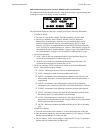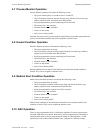
$ODUP2SHUDWLRQ 2SHUDWLQJ,QVWUXFWLRQV
8QLPRGH31&
Pressing the Acknowledge/Step or Alarm Silence key will cause the pulsing piezo to
silence and the system Trouble LED to change from flashing to on steady. This block
acknowledgment occurs regardless of the number of troubles, alarms and supervisory
events active in the system. When the Acknowledge/Step key is pressed and at least one
new alarm or trouble exists in the system, the ‘acknowledge’ message is sent to the printer
and history file. If the trouble clears, either before or after the Acknowledge/Step key is
pressed, the ‘clear trouble’ message is sent to the printer and history file.
If all troubles clear and there are no supervisory or fire conditions active in the system, the
system returns to normal mode operation and the System All Normal message is shown on
the LCD display and sent to the history and printer files. The auto-restore feature will
restore cleared troubles even if the troubles were never acknowledged. Note that pressing
the Alarm Silence key when only troubles exist in the system will have the same effect as
pressing the Acknowledge/Step key except the Alarm Silenced LED will light.
If multiple trouble conditions exist in the system, they will be automatically scrolled on
the LCD display at a three second rate. If a combination of alarms, troubles and/or
supervisory conditions simultaneously occur in the system, only the alarms are scrolled on
the display.
4.5 Alarm Operation
Alarm operation is similar to trouble operation with the following differences:
• The piezo sounder produces a steady output as opposed to a pulsed output
• The Fire Alarm LED flashes 1 second On and 1 second Off
• The LCD displays Alarm along with the device name, type, address, adjective/noun,
associated zones and time/date
• Alarms latch and are not allowed to clear automatically
• Alarms activate software zones if so programmed
• Timers for Silence Inhibit, Autosilence and Trouble Reminder are started
• Alarms activate the general alarm relay and general alarm zone Z00
• The trouble relay is not activated
• Store event in history buffer
A typical alarm display would be as illustrated below:
Note that the device type, which in this example is PULL STATION, can be any other
programmable alarm type.
The information displayed in the above example provides the following information:
• First line in display:
✓ The type of event; in this example ALARM indicating an alarm condition
✓ Device type identifier; in this example, PULL STATION indicates a manual pull
box. Other device type identifiers which can be displayed include SMOKE (ION)
for Ionization Detector, HEAT for Heat Detector, CONTROL for Control Module
and MONITOR for Monitor Module, PULL STATION for a manual pull box, etc.
Refer to "Edit Detector" on page 44, "Edit Module Screen for Monitor Module"
on page 54 and "Edit Module Screen for Control Modules" on page 63 for
information on additional device types.
ALARM PULL STATION
<ADJ> <NOUN>
Z000
10:00A 010801 1M001


















